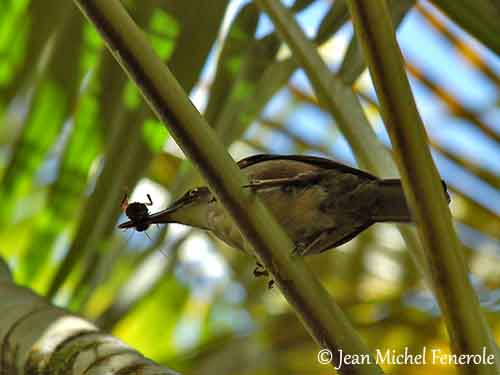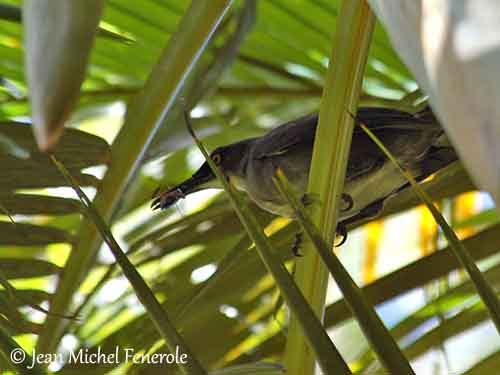
Fr: Trembleur gris
All: Grauzitterdrossel
Esp: Cocobino Gris
Ita: Tremulo grigio
Nd: Grijze Sidderspotlijster
Sd: Grå darrhärmtrast
Photographer:
Jean Michel Fenerole
Photos d’Oiseaux du monde
Text by Nicole Bouglouan
Sources:
HANDBOOK OF THE BIRDS OF THE WORLD Vol 10 by Josep del Hoyo-Andrew Elliott-David Christie - Lynx Edicions - ISBN: 8487334725
WRENS, DIPPERS AND THRASHERS by Brewer David – illustrated by Barry Kent Mackay- Yale University Press - ISBN: 0300090595
BirdLife International (BirdLife International)
Birds & Co – Les Oiseaux de Martinique
Grey Trembler
Cinclocerthia gutturalis
Passeriformes Order – Mimidae Family
INTRODUCTION:
Only found in Martinique and St Lucia, the Grey Trembler shows less sexual dimorphism in bill-length than in the Brown Trembler. Both species frequently quiver their wings. The Grey Trembler is mostly arboreal. It is endemic to the Lesser Antilles.
DESCRIPTION OF THE BIRD:
Biometrics:
Length: 23-26 cm
Weight: 65-76 g
The adult of the nominate race has grey-brown upperparts, including crown, back and wings, the latter usually more dusky. The tail is similar in colour, relatively short and often cocked over the back.
On the underparts, throat and centre of breast and belly are buffy-white, whereas breast sides, flanks and thighs are greyish-brown, with darker flanks. The undertail-coverts are greyish-brown with more or less white margins.
On the grey-brown head, lores and ear-coverts are blackish.
The long, slightly down-curved bill is blackish. The eyes are yellow. Legs and feet are dark brown.
Both sexes are similar in plumage, but the female is slightly smaller and she has 18% longer bill than male.
The juvenile is browner than adults, with mottled breast and dark grey eyes.
SUBSPECIES AND RANGE:
There are two subspecies.
C.g. macrorhyncha occurs on St Lucia, in SC Lesser Antilles. This race has dull buffy-white to pale greyish-buff underparts. Undertail-coverts and flanks are pale cinnamon, and the sides are tinged olive greyish.
C.g. gutturalis (here described and displayed) is found in Martinique, on C Lesser Antilles.

HABITAT:
The Grey Trembler frequents mature moist forests, both in lowland and mountains. It is less visible in drier areas.
Less restricted to humid habitats than the Brown Trembler, it is more general in habitat.
CALLS AND SONGS: SOUNDS BY XENO-CANTO
The Grey Trembler utters repeated notes and wavering, whistled phrases, from harsh to melodious. It also gives harsh scold and call notes, and quavering whistles.
BEHAVIOUR IN THE WILD:
The Grey Trembler feeds on insects, small vertebrates, fruits and berries. This arboreal species forages among the vegetation, probing into epiphyte clusters with its long bill, and tearing open tangles. Like the Brown Trembler, it forages at all levels in vegetation, and also on the ground.
The Grey Trembler is often seen alone. It frequently quivers its half-open drooped wings, like numerous Mimidae species. This behaviour appears more frequent during the breeding season. An observation mentions two birds in tree, moving from branch to branch. One of the birds, probably the male, is perched and swings from side to side with stretched neck while turning the head. The half-open drooped wings are quivering nervously.
The Grey Trembler is sedentary in its range.

REPRODUCTION OF THIS SPECIES:
The breeding season occurs between March and August.
The nest is apparently domed, that is unusual in Mimidae. The domed structure has a side entrance. It is made with dry grass, and is often placed in a palm, or in hollow in tree, or in crotch.
The female lays 2-3 greenish-blue, unmarked eggs.
PROTECTION / THREATS / STATUS:
The Grey Trembler is fairly common throughout its restricted range on two islands.
The global population is suspected to be stable, and the species is not currently threatened.